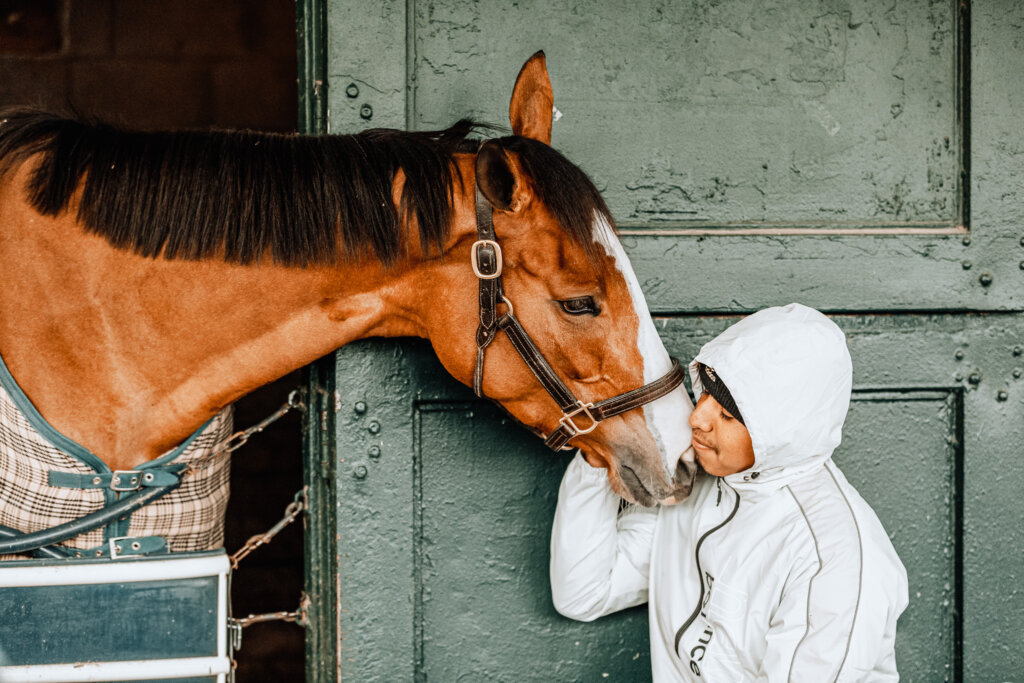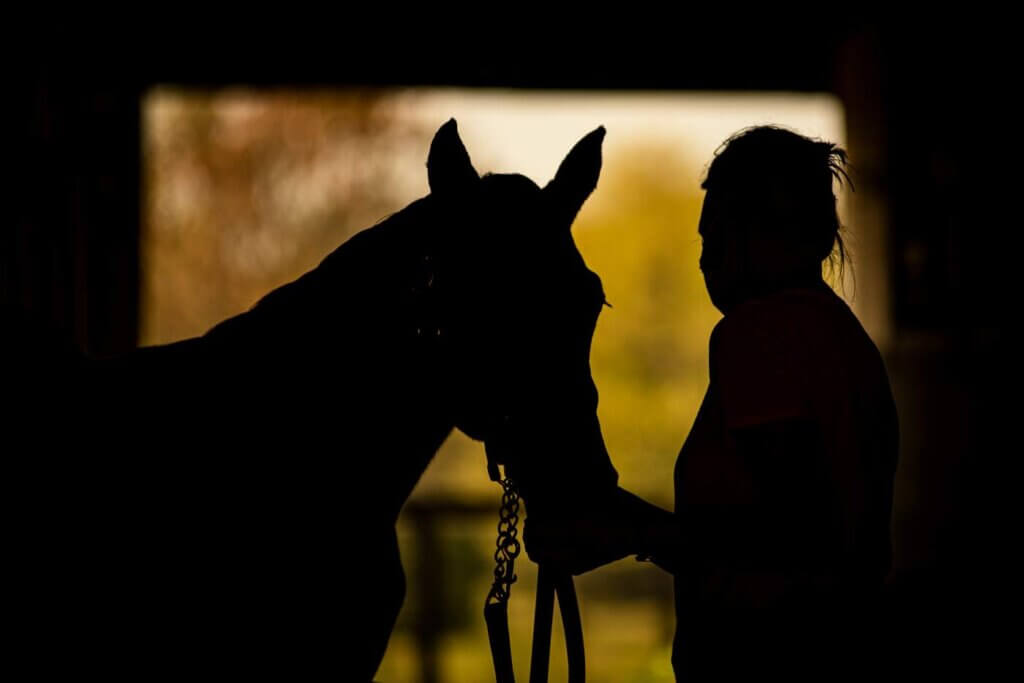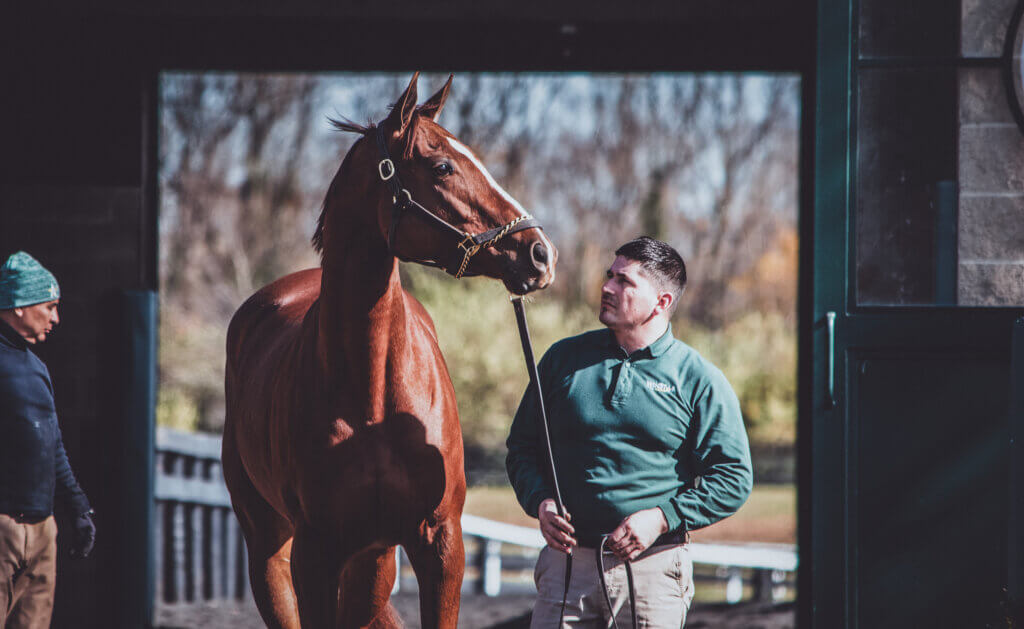The theory suggesting that horses live in barns for human convenience is illogical. Indeed, maintaining barns requires considerable time and effort, including cleaning, frequent exercise outings, and individual feeding and watering.
Conversely, a horse in pasture will exercise itself, it can eat grass whenever it likes and typically have access to reliable water sources. Therefore, it takes much less labor and less money to keep horses in pastures.
So, why do trainers keep racehorses indoors?
Some of the many factors include these main theories:
- Barns provide warmth, shelter, and safety from the elements.
- Well-designed barns allow horses to be sociable.
- Barns prevent horses from hurting each other.
- Barns allow a trainer to manage and monitor the athlete’s diet and nutritional needs.
Warmth, Shelter and Friends
Efforts are made to make sure barns are well designed with ventilation to help prevent respiratory disease. Barns protect horses from the sun, shelter them from storms, high winds, and other bad weather.
Aren’t horses isolated in barns? No. Horses are free to move inside their stall with open grills designed for the top half of their stall so they can chat with their neighboring horses. Because horses that are more comfortable are happier, trainers make sure horses are stabled beside friends (just like humans, not all horses like each other!).
Almost every racehorse is stabled overnight, with a blend of indoor and outdoor relaxation time during the day, depending on a trainer’s facilities and what suits the individual horse.

Injury Prevention
The most common injuries to horses occur when they are in pastures running together in groups. A recent study at the University of Zurich looked at 1,845 fracture cases in horses (of all breeds) and found that 43% were caused by a kick from another horse, with 70% of horses recovering from the injury.
The study also found that the largest percentage of fractures occurred while horses were in pastures (28%) and another 10% in ‘group indoor housing’ (used in parts of the Northern Hemisphere for non-Thoroughbreds during winter). Fractures occurring in barns were only 8% of the total.
A study analyzing responses from 652 horse owners revealed that 62% of injuries occurred during turnout, compared to only 13% during ridden exercise.
According to research funded by The Horse Trust, a study analyzing responses from 652 horse owners revealed that 62% of injuries occurred during turnout, compared to only 13% during ridden exercise. Interestingly, only 11% of injuries were reported to occur in the stable, with most of these affecting the head or eye.
It’s noteworthy that horses that had been owned for a shorter period were more at risk of injury, likely due to aggression from other horses when a new one is introduced to a field. The study also found that horses turned out in larger groups were at an increased risk of injury, probably due to a larger hierarchy and competition for dominance.
Gut Health and Diet
Equine nutritionists have spent a lot of time and research effort in generating appropriate diets to keep horses healthy and well nourished. State of the art nutrition research is employed to design diets specifically for racehorses and care is taken to make sure their food and hay is of good quality and appetizing. Quality hay is typically available for them to nibble on 24-7.
Every athlete, horse and human, needs a specialist diet, to allow them to perform at their best and to meet their individual nutritional requirements. “Half the training is in the feeding” is a saying commonly attributed to trainers.
The science of equine nutrition continues to advance, and trainers who utilize sports science to keep their horses in optimal good health and top condition will win more consistently. Trainers have long been adapting their feeding programs according to the latest available evidence. For example, trainers now understand the importance of providing constant access to forage (hay) to replicate their natural foraging tendencies.
An example of adapting feeding programs, thanks to science, is hay steamers. Fiber is a necessary part of a horse’s diet, which is provided by hay. The purpose of steaming is to purify hay and reduce the health threat from respirable dust, mold spores, and pathogens.

In terms of negativity around stabling, there have been suggestions that stall housing might be a risk factor for equine gastric ulcers. However a study that investigated the impact of different housing situations (grass paddock, stall alone, or stall with an adjacent companion) on the pH levels in various parts of a horse’s stomach found that changing the housing situation did not cause any significant alteration.
While stabling can have some risks, the majority of horse injuries appear to occur in the paddock, often due to social dynamics and environmental factors.
SOURCES
Donati, B., Fürst, A.E., Hässig, M. and Jackson, M.A. (2018) Epidemiology of fractures: The role of kick injuries in equine fractures. Equine Veterinary Journal, [online] 50(5), pp.580–586. doi: https://doi.org/10.1111/evj.12819
Moore-Colyer, M.J.S., Taylor, J.L.E. and James, R. (2016) The Effect of Steaming and Soaking on the Respirable Particle, Bacteria, Mould, and Nutrient Content in Hay for Horses. Journal of Equine Veterinary Science, 39, pp.62–68. doi: https://doi.org/10.1016/j.jevs.2015.09.006
Kaya, G., Sommerfeld-Stur, I. and Iben, C. (2009) Risk factors of colic in horses in Austria. Journal of Animal Physiology and Animal Nutrition, 93(3), pp.339–349. doi: https://doi.org/10.1111/j.1439-0396.2008.00874.x
Hudson, J.M., Cohen, N.D., Gibbs, P.G. and Thompson, J.A. (2001) Feeding practices associated with colic in horses. Journal of the American Veterinary Medical Association, [online] 219(10), pp.1419–1425. doi: https://doi.org/10.2460/javma.2001.219.1419



